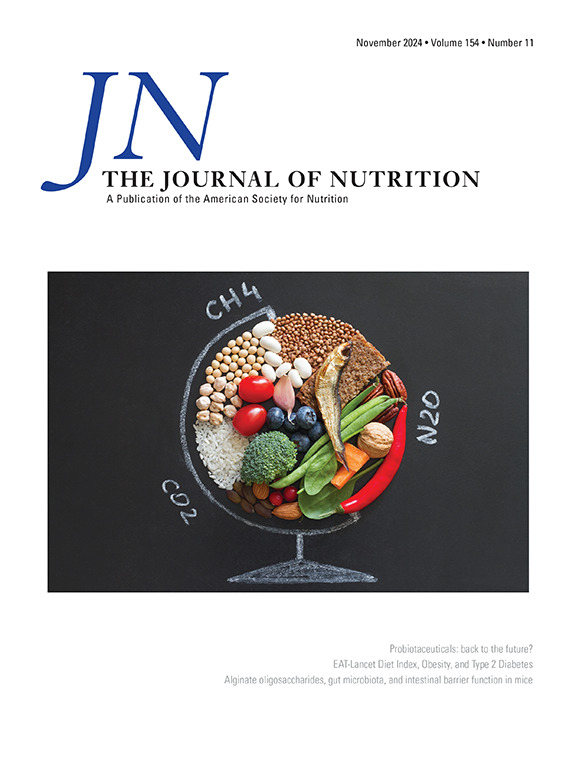A Comparison of Dry Bean and Pea Consumption on Serum Cholesterol: A Randomized Controlled Trial in Adults with Mild Hypercholesterolemia
IF 3.7
3区 医学
Q2 NUTRITION & DIETETICS
引用次数: 0
Abstract
Background
Diets including pulses are associated with better cardiovascular profiles, including lipid, glycemia, and hemodynamics; however, evidence is lacking regarding the contributions of individual pulse varieties.
Objectives
This randomized, controlled trial examined the effects of beans or peas individually, relative to rice, on LDL-cholesterol levels (primary outcome) and other indices of cardiovascular disease risk (secondary outcomes) at 6 wk in adults with mild hypercholesterolemia.
Methods
This randomized, controlled, single-blind, 3-arm parallel-group study was conducted in 2 Canadian cities (Edmonton, Alberta; Winnipeg, Manitoba). Participants (n = 60 per group) were randomly assigned to 6 wk of regular consumption of foods containing either 120 g (∼0.75 cups) of beans (mixture of black, great northern, navy, and pinto) or 120 g (∼0.75 cups) peas (mixture of yellow and green), or identical foods containing white, parboiled rice (control foods). LDL-cholesterol (primary outcome) and indices of lipid metabolism, glycemia, and hemodynamics (secondary outcomes) were assessed.
Results
Mean LDL-cholesterol was lower in the bean group (−0.21; 95% CI: −0.39, −0.03) but not the pea group (−0.11; 95% CI: −0.29, 0.07) relative to rice after 6 wk. Non-HDL-cholesterol (−0.20; 95% CI: −0.40, −0.002) and total cholesterol (−0.28; 95% CI: −0.49, −0.06) were also lower in the bean compared with rice groups. No changes were noted in triglycerides (−0.07; 95% CI: −0.28, 0.14), glucose (0.02; 95% CI: −0.17, 0.14), insulin (4.94; 95% CI: −5.51, 11.38), or blood pressure (systolic: −1.39; 95% CI: −5.18, 2.40; diastolic: −1.89; 95% CI: −4.65, 0.88). Dietary fiber intake (grams per day or grams per 1000 kcal) was not correlated with LDL-cholesterol (grams per day: r2 = 0.209, P = 0.142; grams per 1000 kcal: r2 =0.126, P = 0.379) in the bean group. Gastrointestinal effects were transient and most often not related to the study foods.
Conclusions
Beans, but not peas, lowered LDL-cholesterol, relative to rice, in adults with mild hypercholesterolemia. Fiber may not be responsible for the effect of beans, suggesting other phytochemicals may be the active component(s). Strategies incorporating 120 g of pulses in a meal are feasible for managing some cardiometabolic risk factors.
This trial was registered at clinicaltrials.gov as NCT01661543.
比较食用干豆和豌豆对血清胆固醇的影响:一项针对轻度高胆固醇血症成人的随机对照试验。
背景:包括豆类在内的膳食与更好的心血管状况(包括血脂、血糖和血液动力学)有关,然而,关于单个豆类品种的贡献还缺乏证据:这项随机对照试验研究了豆类或豌豆对轻度高胆固醇血症成人 6 周后的低密度脂蛋白胆固醇水平(主要结果)和其他心血管疾病风险指数(次要结果)的影响:这项随机对照、单盲、三组平行研究在加拿大两个城市(艾伯塔省埃德蒙顿市和马尼托巴省温尼伯市)进行。参与者(n=60/组)被随机分配到定期食用 120 克(∼¾ 杯)豆类(黑豆、北部大豆、海军豆、平托豆的混合物)或 120 克(∼¾ 杯)豌豆(黄豆、绿豆的混合物)的食物或含有白煮饭的相同食物(对照食物)的 6 周实验中。对低密度脂蛋白胆固醇(主要结果)以及脂质代谢、血糖和血液动力学指标(次要结果)进行了评估:结果:6 周后,相对于米饭,豆类组(-0.21,-0.39 --0.03)的低密度脂蛋白胆固醇(平均值,(95%CI))低于豌豆组(-0.11,-0.29 -0.07)。豆类组与大米组相比,非高密度脂蛋白胆固醇(-0.20,-0.40 - -0.002)和总胆固醇(-0.28,-0.49 - -0.06)也有所降低。甘油三酯(-0.07,-0.28-0.14)、葡萄糖(0.02,-0.17-0.14)、胰岛素(4.94,-5.51-11.38)或血压(收缩压:-1.39,-5.18-2.40;舒张压:-1.89,-4.65-0.88)均无变化。豆类组的膳食纤维摄入量(克/天或克/1000 千卡)与低密度脂蛋白胆固醇(克/天:r2=0.209,p=0.142;克/1000 千卡:r2=0.126,p=0.379)不相关。对胃肠道的影响是短暂的,通常与研究食物无关:结论:相对于米饭,豆类(而非豌豆)能降低轻度高胆固醇血症成人的低密度脂蛋白胆固醇。纤维可能不是豆类产生效果的原因,这表明其他植物化学物质可能是豆类的活性成分。在膳食中加入 120 克豆类的策略对于控制某些心脏代谢风险因素是可行的:临床试验登记:Clinical Trials.Gov NCT01661543。
本文章由计算机程序翻译,如有差异,请以英文原文为准。
求助全文
约1分钟内获得全文
求助全文
来源期刊

Journal of Nutrition
医学-营养学
CiteScore
7.60
自引率
4.80%
发文量
260
审稿时长
39 days
期刊介绍:
The Journal of Nutrition (JN/J Nutr) publishes peer-reviewed original research papers covering all aspects of experimental nutrition in humans and other animal species; special articles such as reviews and biographies of prominent nutrition scientists; and issues, opinions, and commentaries on controversial issues in nutrition. Supplements are frequently published to provide extended discussion of topics of special interest.
 求助内容:
求助内容: 应助结果提醒方式:
应助结果提醒方式:


